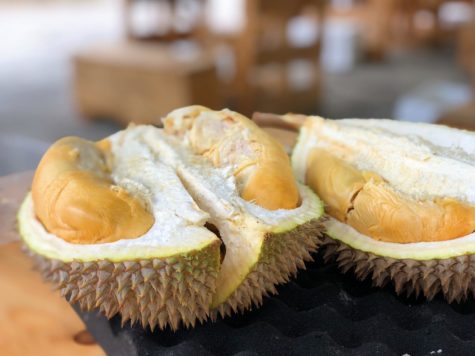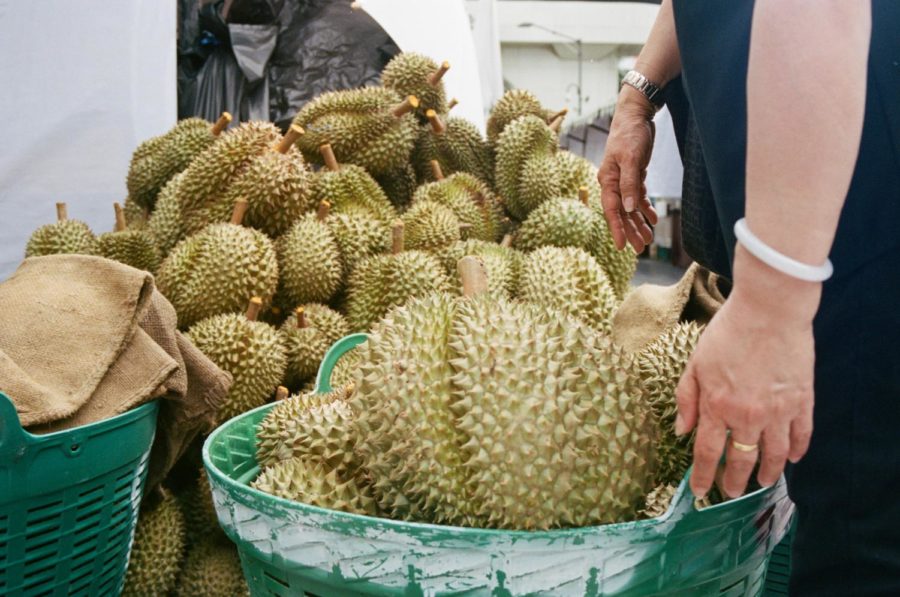In Defense of Durian: A Delicious and Versatile ‘King of Fruits’
Durian is a fruit that is considered a delicacy by many, yet it is most known for its strong smell. However, the fruit native to the Southeast Asian region deserves more respect and appreciation for its unique flavor profile and appearance, rather than just being associated with its scent alone.
Many different types of durian are sold in markets throughout Asia from July through October, each year. Before durian are sold, the fruit sellers have to make sure that the durian fruits are completely ripe and ready to eat.
Durian is probably the most polarizing fruit in the world. Native to Borneo and Sumatra in Indonesia, the durio zibethinus grows from nectary flowers pollinated by bats during the summer months of June, July, and August. Once ripe, its large, spiky shell can be chopped open to reveal bright yellow flesh. Its taste is custard-like, sweet, and similar to a mix of vanilla and caramel with hints of a savory flavor – however, while the fruit may be delicious, it possesses an odious smell that causes many people to turn away from it.
The word “durian” itself means “thorny one” in the Malay language, referencing its spiky appearance and large, round shape. The tall durian trees are common in Southeast Asian countries, meaning that the creamy fruit is one of the favorite treats to snack on for all ages. Go to any Southeast Asian supermarket, and you will see crowds shopping for durian fruit, durian chips, durian ice cream, and even durian wafers. However not everyone likes the fruit, with some even shuddering at the thought of products of the stinky fruit in stores.
To Southeast Asians, durian is a normal fruit that people grow in their backyards and eat for dessert. The durian fruit has been the subject of much discussion on the internet as well. On YouTube, many people have tried the durian fruit for the first time on camera, recording their initial reactions.
The notorious reputation of the durian fruit causes people to steer away from it altogether, even though they have not given it a taste.“I never tried durian specifically, but I had previous experience with food that people say smells bad but tastes good,” said Debanjoli Chowdhury ’23 about her experience with durian. “I have a very sensitive sense of smell, so I don’t typically enjoy these types of food.”
As a former durian-hater, I understand the widespread disgust towards this fruit. It is not small and “normal-looking” like strawberries or blueberries, and it certainly does not have an appealing flavor like bananas or watermelon. Growing up with durian-loving parents, I always left the room whenever they cut one of the thick bowling balls open. I hated how the stench took over the whole house while I just wanted to smell my surroundings in peace, and the fruit looked scary to me. I just wanted to smell my surroundings in peace, but the durian barred me from doing so. Though durian is a huge part of my family’s culture, I thought that it was foreign, as it did not look like the fruits my friends ate at school, nor was it sold in places like Whole Foods. It took me an embarrassingly long time to understand the beauty of the fruit, and truly feel more connected to my family’s food preferences.

Being from the durian-exporting region of Southern Thailand, and growing up near the Malaysian border, my parents essentially grew up eating durian very often. My grandparents even grew a few durian trees near their house in Nakhon Si Thammarat. It was an important part of their culture, but not for me as I grew up in New York City. The majority of people around me were not exposed to durian and saw it as unusual, so I followed this sentiment and closed myself off to the fruit. Though my parents tried their best to have me take a bite of durian when I was younger, I resisted hard because I felt that it was disgusting and unusual. My parents never forced me to eat it, however, since they knew that a six-year-old me would have raised a temper tantrum. But, now that I am older, I have gained more of an appreciation for the fruit. I have gotten used to the smell and even tried durian ice cream, which is an improvement from not going near it in the supermarket!
Recently, I became curious about the fruit, so I asked my parents about the cultivation process and how durian trees grow in Southeast Asia. After talking to my mother, I learned that gathering durian fruits is a very interesting process. “In order to eat durian, you would have to wait for the ripe fruit to fall off the tree in the morning. If you don’t want to get hit on the head by one, you would need to wait to go under the trees later in the day,” my mother explained. “But people who make money off of selling durian cut them down the tree before they’re ripe so they become ripe right as they get into the markets.” When I pondered about what I was told about durian’s growth cycle, I realized that it must be challenging to carry all the heavy fruit. I found that the cultivation process is tough labor, and I was impressed by how much work farmers put in order for people to enjoy their creamy snacks.
Cutting the fruit itself is also quite the show of physical strength. Not only is durian as heavy as a dumbbell, it also takes a lot of effort to open it. Usually, faint lines near the bottom form the shape of a star where it is easiest to cut. But, to access these, you would need to find the perfect spot between the mountain of spikes. Once the incisions are made, the durian needs to be ripped apart with all the forearm muscles you can muster up. Watching my parents rip open the hard shell of the fruit made me realize that I definitely underestimated the toughness they required to enjoy dessert – simply getting it open is a workout in itself.
While it may be a difficult task to retrieve the flesh from inside the shell, it is well worth the wait for its cheesecake-like combination of flavors. Durian flesh is good to eat by itself, but it is also surprisingly versatile for a delicacy with such a unique combination of flavors. There are many creative snacks and desserts in different brands and restaurants, which brings more positive attention to the durian fruit itself. When asked about her opinion on durian treats, Tazkiah Salam ’23 said, “I like durian because they are sweet and have a unique taste from other fruits. I also like how you can use the fruit to make durian soups.” I personally believe durian goes especially well with coconut milk, and it tastes very good in cold treats like shaved ice. Perhaps more people would be more open to trying durian if they knew about the variety of appealing forms they can try it in.
No matter how many people may dislike durian or even avoid it, I will always have a place of appreciation for it in my heart. As I am working on incorporating durian more into my life, I hope that more people open their minds and do the same. The sheer variety and uniqueness of the flavor should draw people in to being more open about trying durian despite its smell. At first glance, fruits and other foods like durian are dismissed, as they do not seem appealing at first glance – whether it is because of its appearance, smell, or size.
In a way, durian fruit reminds me of a cactus. Cacti evolved in deserts, giving them spikes to prevent themselves from being consumed by other animals, which therefore provides them with an intimidating appearance. However, they have a secret importance to them, as they store water inside their tough skin. Many desert animals, such as camels, woodrats, iguanas, and tortoises rely on consuming cacti to hydrate themselves, meaning that the plant is rather important. Those animals evolved over a long period of time to adapt to the spikes of the cactus plants. Durian similarly has a rough outer appearance and a hidden value to their inside once consumed. Furthermore, people need to change their mindsets and become exposed to durian before enjoying eating it, in likeness to how animals changed over millions of years to eat cacti.
Durian – like escargot, natto, oysters, and vegemite – are all acquired tastes, since many people will judge the foods without trying them, believing that it will taste bad by its appearance or texture. However, people should be more open-minded towards foods without forcing their prior judgements. After all, “acquired taste” means that most people eventually take a liking to these “strange” foods as they become more exposed to them. If people become more open to trying and learning about durian, there is a possibility that there may be more appreciation for the fruit. There is no fruit as unique in shape, harvest, flavor, and scent as this delicious and versatile fruit that grows on tall trees in Southeast Asia. It’s truly no wonder that durian is called the King of Fruits.
“In order to eat durian, you would have to wait for the ripe fruit to fall off the tree in the morning. If you don’t want to get hit on the head by one, you would need to wait to go under the trees later in the day,” my mother explained. “But people who make money off of selling durian cut them down the tree before they’re ripe so they become ripe right as they get into the markets.”
Irene Yimmongkol is an Arts & Entertainment editor for ‘The Science Survey.' She edits her peers’ articles that go in the Arts & Entertainment...











